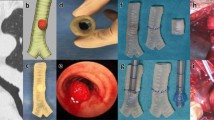Abstract
Purpose
The slide tracheoplasty (STP) is the standard treatment for severe congenital tracheal stenosis (CTS). Understanding the features of the tracheal stenosis in each case and choosing an appropriate incision design are very important for successfully executing the procedure. The present study aimed to evaluate the advantages of three-dimensional (3D) printed models of the trachea for improving CTS.
Methods
Three-D tracheal models were created using computed tomography (CT) data from ten patients undergoing STP for CTS. Simulated surgery was performed using the hollow models after reinforcing with them with a coating of gum spray. Clinical outcomes, including patient survival, postoperative surgical interventions, and time required for STP, were compared with the corresponding values in the last ten patients before the introduction of 3D model simulations.
Results
All ten patients for whom simulated surgery using a 3D tracheal model were conducted achieved good airway patency after their STP. The surgeons reported feeling that the 3D model simulations were highly effective although there was no significant difference in the clinical outcomes of the groups with or without simulated STP. The models were useful not only for surgical planning but also for sharing important information among the multidisciplinary team and the patients’ family.
Conclusion
Our experience using 3D tracheal models demonstrated several features enabling improvement in the surgical treatment of CTS.





Similar content being viewed by others
References
Grillo HC (1994) Slide tracheoplasty for long-segment congenital tracheal stenosis. Ann Thorac Surg. https://doi.org/10.1016/0003-4975(94)90714-5
Balakrishnan K, Cofer S, Matsumoto JM, Dearani JA, Boesch RP (2017) Three-dimensional printed models in multidisciplinary planning of complex tracheal reconstruction. Laryngoscope 127:967–970. https://doi.org/10.1002/lary.26353
Arcieri L, Giordano R, Bellanti E, Chiappino D, Murzi B (2018) Impact of 3D printing on the surgical management of tracheal stenosis associated to pulmonary sling: a case report. J Thorac Dis 10:E130-e133. https://doi.org/10.21037/jtd.2017.12.141
McMahon CJ, Ayoubi K, Mehanna R, Phelan E, O’Cearbhaill E, Russell J, Nölke L (2020) Outcome of congenital tracheal stenosis in children over two decades in a national cardiothoracic surgical unit. Cardiol Young 30:34–38. https://doi.org/10.1017/s1047951119002725
Richardson C, Friedman SD, Park JS, Bonilla-Velez J, Dahl JP, Parikh SR, Perkins J, Johnson K (2022) Comparison of slide tracheoplasty technique on postoperative anatomic outcomes in three-dimensional printed models. Laryngoscope 132:1306–1312. https://doi.org/10.1002/lary.29874
Shimojima N, Shimotakahara A, Tomita H, Harumatsu T, Harada A, Maeda Y, Ito Y, Miyaguni K, Tsukizaki A, Abe K, Hashimoto M, Ishikawa M, Honda M, Kuroda T, Hirobe S (2022) Outcomes of slide tracheoplasty for congenital tracheal stenosis in 80 children: a 22 year single-center experience. J Pediatr Surg. https://doi.org/10.1016/j.jpedsurg.2022.02.033
Toma M, Kamagata S, Hirobe S, Komori K, Okumura K, Mutoh M, Hayashi A (2009) Modified slide tracheoplasty for congenital tracheal stenosis. J Pediatr Surg 44:2019–2022. https://doi.org/10.1016/j.jpedsurg.2009.06.018
Hashimoto K, Ichinose J, Matsuura Y, Nakao M, Mun M (2022) A 3-dimensional airway model for tracheobronchial surgery. JTCVS Tech Press. https://doi.org/10.1016/j.xjtc.2022.01.024
Acknowledgements
We thank Mr. James R Valera for his assistance with editing the manuscript. We also appreciate the support for this work by a grant from the Tokyo Metropolitan Government.
Funding
Funded by a grant from the Tokyo Metropolitan Government.
Author information
Authors and Affiliations
Contributions
N.S. wrote the main manuscript text. N.S., A.S., H.T. and S.H. performed simulation using models as operating surgeons. All authors reviewed the manuscript.
Corresponding author
Ethics declarations
Conflict of interest
The authors declare that they have no conflicts of interest.
Additional information
Publisher's Note
Springer Nature remains neutral with regard to jurisdictional claims in published maps and institutional affiliations.
Rights and permissions
Springer Nature or its licensor holds exclusive rights to this article under a publishing agreement with the author(s) or other rightsholder(s); author self-archiving of the accepted manuscript version of this article is solely governed by the terms of such publishing agreement and applicable law.
About this article
Cite this article
Shimojima, N., Shimotakahara, A., Tomita, H. et al. Simulated slide tracheoplasty for congenital tracheal stenosis using three-dimensional printed models. Pediatr Surg Int 38, 1895–1902 (2022). https://doi.org/10.1007/s00383-022-05229-5
Accepted:
Published:
Issue Date:
DOI: https://doi.org/10.1007/s00383-022-05229-5




